Matthew Houde's Blog, page 42
July 25, 2012
TOP 5 THINGS TO DO IN COSTA RICA'S CENTRAL PACIFIC
Costa Rica’s Central Pacific spans the coastal areas from Puntarenas and Jacó to the north to Manuel Antonio and beyond to the south. Although this region is not substantial in size, it boasts a number of tourist attractions. From misty cloud forest to tropical rainforest and beautiful beaches, the Central Pacific has it all. And due to its easy accessibility from the San José international airport (a short, two-hour drive), it’s an ideal destination for a week-long getaway.
We have many favorite places in the Central Pacific—too many to count, really. But the list below provides our all-time top picks.
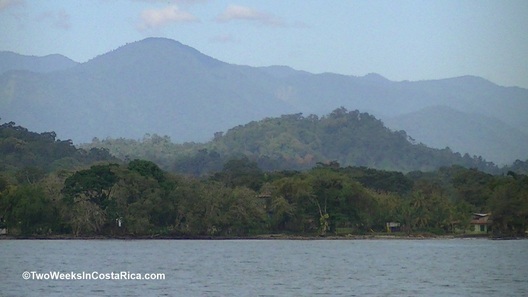
#5 Dinner at Ronny’s Place
If you’re in Manuel Antonio, don’t miss this hidden gem. Located off the main strip across from Amigos del Río, about a half-mile down a bumpy dirt road, Ronny’s Place is surely not easy to get to, but the trip is well worth it. Because it’s situated high up on a ridge that juts out into the Pacific, Ronny’s Place has stunning ocean views. Be sure to arrive in time for sunset—it is spectacular. Not only are the views great, but the waitstaff is friendly and fun, especially Tico owner Ronny himself. The menu includes typical local food and lots of fresh seafood. For Ronny’s special show after dark, order the bananas flambé for dessert (we don’t want to ruin the surprise; trust us on this one).
#4 Take a Zip-line Tour
Take a break from the beach for a zip-lining adventure in the mountains. There are several reputable tour operators in Jaco, Quepos, and Manuel Antonio through which you can book a tour, or you can book through most hotels. Tours usually include transportation to the mountains, all the equipment you’ll need, and a meal. Prices vary but typically range from $50 to $100. For more information on zip-lining in Costa Rica, check out this post from our archives.
#3 Explore Manuel Antonio National Park
This park is one of Costa Rica’s most visited, and for good reason. With beaches, hiking, and all the wildlife for which Costa Rica is famous (sloths, monkeys, and birds, oh my!), Manuel Antonio National Park is a destination that appeals to people seeking relaxation and adventure alike. Be sure to grab a fresh coconut from one of the locals on your way out. There’s nothing like sucking down refreshing coconut water after a long, hot day. To learn more about what the park has to offer, see our separate post.
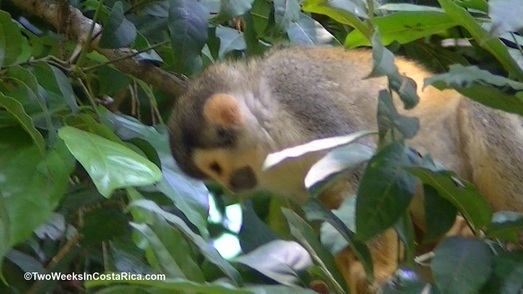 Squirrel Monkey (known locally as the Titi)
Squirrel Monkey (known locally as the Titi)
#2 Discover Uvita’s Whale Tail
Located in Costa Rica’s only underwater marine park, Marino Ballena, Uvita’s famed whale tail is a sandbar that stretches almost one kilometer into the ocean. This tail-shaped sandbar is formed by the converging currents of two adjacent coves. It has changed shape over the years, due to storms and changes in weather patterns, but it always seems to get its characteristic whale-tail shape back. It is a sight to see from the land, but if you’re ever on a small plane, the view from the sky is outstanding.
#1 Watch the Sunset in Quepos
Our top activity in the Central Pacific is hanging out on the breakwater in Quepos with the locals at sunset. Our Costa Rican friend, Roy, first turned us on to this awesome (and free) activity a few years back. We've also spent sunset at the restaurant in the Best Western Hotel Kamuk, Restaurante Mira Olas, which has a great third-story outdoor dining area overlooking the bay. You won’t get the same cultural experience at the restaurant as you would on the breakwater, but no matter where you enjoy the view, it is stunning.
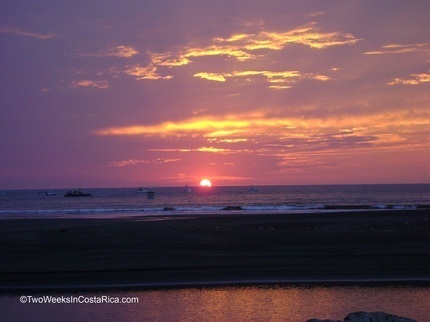 Questions?
Questions?
Can't find Ronny's Place? Don't know what tour company to use? Just want some general advice on how to have a blast on your trip to Costa Rica? Post a comment or shoot us an email. We're here to help!
To learn more about Costa Rica, buy our book, Two Weeks in Costa Rica. It's a travelogue with a guidebook twist.
Read reviews and excerpts on Amazon.com.

We have many favorite places in the Central Pacific—too many to count, really. But the list below provides our all-time top picks.

#5 Dinner at Ronny’s Place
If you’re in Manuel Antonio, don’t miss this hidden gem. Located off the main strip across from Amigos del Río, about a half-mile down a bumpy dirt road, Ronny’s Place is surely not easy to get to, but the trip is well worth it. Because it’s situated high up on a ridge that juts out into the Pacific, Ronny’s Place has stunning ocean views. Be sure to arrive in time for sunset—it is spectacular. Not only are the views great, but the waitstaff is friendly and fun, especially Tico owner Ronny himself. The menu includes typical local food and lots of fresh seafood. For Ronny’s special show after dark, order the bananas flambé for dessert (we don’t want to ruin the surprise; trust us on this one).
#4 Take a Zip-line Tour
Take a break from the beach for a zip-lining adventure in the mountains. There are several reputable tour operators in Jaco, Quepos, and Manuel Antonio through which you can book a tour, or you can book through most hotels. Tours usually include transportation to the mountains, all the equipment you’ll need, and a meal. Prices vary but typically range from $50 to $100. For more information on zip-lining in Costa Rica, check out this post from our archives.
#3 Explore Manuel Antonio National Park
This park is one of Costa Rica’s most visited, and for good reason. With beaches, hiking, and all the wildlife for which Costa Rica is famous (sloths, monkeys, and birds, oh my!), Manuel Antonio National Park is a destination that appeals to people seeking relaxation and adventure alike. Be sure to grab a fresh coconut from one of the locals on your way out. There’s nothing like sucking down refreshing coconut water after a long, hot day. To learn more about what the park has to offer, see our separate post.
 Squirrel Monkey (known locally as the Titi)
Squirrel Monkey (known locally as the Titi) #2 Discover Uvita’s Whale Tail
Located in Costa Rica’s only underwater marine park, Marino Ballena, Uvita’s famed whale tail is a sandbar that stretches almost one kilometer into the ocean. This tail-shaped sandbar is formed by the converging currents of two adjacent coves. It has changed shape over the years, due to storms and changes in weather patterns, but it always seems to get its characteristic whale-tail shape back. It is a sight to see from the land, but if you’re ever on a small plane, the view from the sky is outstanding.
#1 Watch the Sunset in Quepos
Our top activity in the Central Pacific is hanging out on the breakwater in Quepos with the locals at sunset. Our Costa Rican friend, Roy, first turned us on to this awesome (and free) activity a few years back. We've also spent sunset at the restaurant in the Best Western Hotel Kamuk, Restaurante Mira Olas, which has a great third-story outdoor dining area overlooking the bay. You won’t get the same cultural experience at the restaurant as you would on the breakwater, but no matter where you enjoy the view, it is stunning.
 Questions?
Questions?Can't find Ronny's Place? Don't know what tour company to use? Just want some general advice on how to have a blast on your trip to Costa Rica? Post a comment or shoot us an email. We're here to help!
To learn more about Costa Rica, buy our book, Two Weeks in Costa Rica. It's a travelogue with a guidebook twist.
Read reviews and excerpts on Amazon.com.

Published on July 25, 2012 17:15
June 24, 2012
MANUEL ANTONIO NATIONAL PARK
If you’re looking for picturesque beaches, wild jungle, and up-close encounters with wildlife, Manuel Antonio National Park is for you. Located just two hours from Costa Rica’s San José international airport on the beautiful Central Pacific coast, Manuel Antonio National Park is a family-friendly destination with hiking, swimming, and lots and lots of monkeys.
What to Do:
Hiking: The park has five trails. Most trails have fairly flat terrain suitable for all levels, but some have steeper inclines. The park has free trail maps available at the ticket booth, so be sure to take one. Short on time? Stay on the main trail; we’re always astounded at the amount of wildlife hanging out right off the main trail. Have time to spare? Go deeper into the jungle and check out the trails off the main path. They lead to spectacular lookouts, secluded beaches, and see a lot less foot-traffic, so you’re more likely to see rare wildlife. Be sure to keep your eyes and ears open for endangered squirrel monkeys, white-faced capuchin monkeys, howler monkeys, three- and two-toed sloths, coatis, and agoutis that frequent the park.
 View from the lookout at Sendora Mirador (Viewpoint Trail)
View from the lookout at Sendora Mirador (Viewpoint Trail)
Beaching it: The park has three beaches that are off-limits to everyone but park visitors. The most famous is the first one off the main trail: Playa Manuel Antonio, a stunning cove with shimmering aquamarine water and ivory sand. With lots of shady almond trees, this beach is perfect for a day of lounging around with a good book. The calm water and sandy sea floor make it a great spot for swimming too.
Snorkeling: There’s some decent snorkeling along the rocks at Playa Manuel Antonio. If conditions are right and the water isn’t too choppy, you’ll be able to see all kinds of tropical fish, from schools of snapper to pufferfish to colorful damselfish.
A Couple Tips:
Got food? Then you better watch out for monkeys! Troops of white-faced monkeys are known to come down to the beach at Playa Manuel Antonio for hand-outs around lunchtime. We’ve even seen them break into the backpacks of unassuming tourists, so keep your belongings in sight at all times. Love the monkeys? Then help keep the monkey population healthy and resist the urge to feed them. Monkeys are extremely sensitive to the bacteria on human hands and can become sick or even die by eating foods that people have touched. Spread the word!
 A white-faced capuchin monkey charming park visitors
A white-faced capuchin monkey charming park visitors
Want to avoid the crowds? Skip Playa Manuel Antonio and claim your own piece of paradise at Playa Espadilla Sur farther down the main trail. This beach isn’t quite as picturesque as Playa Manuel Antonio, but having it all to yourself may be worth it.
To Tour or Not to Tour:
Exploring the park on a guided tour is a great option if you haven’t visited before. A guide will teach you about the native plants and animals and spot hidden wildlife with their trained eye. Guides also have powerful scopes that can get you up close and personal with an animal without disturbing it (we’ve even seen the green algae growing in the fur of a slow-moving sloth high up in a tree!).
Not sure you need a guide? If you’ve hiked in Costa Rica before, you can probably manage by yourself and may even see more wildlife on your own because guides work on a time limit, stay on the main trail, and travel with large groups that can scare off wildlife.
When to Go:
Manuel Antonio National Park is one of the busiest parks in Costa Rica. Arrive early to avoid the crowds, especially on weekends. Tour groups typically start showing up around 8:30 a.m., so it’s best to arrive closer to when the park opens at 7:00. Note that in an effort to limit the impact of visitors on local wildlife, the park is closed on Mondays and the number of visitors per day is capped (600 on weekdays and 800 on weekends).
 Questions/Comments:
Questions/Comments:
Have questions? Send them our way. We’d love to help you plan your visit to the park!
Been before? Please share your experience. What did you think of the monkeys???
To learn more about Costa Rica, buy our book, Two Weeks in Costa Rica. It's a travelogue with a guidebook twist.
Read reviews and excerpts on Amazon.com
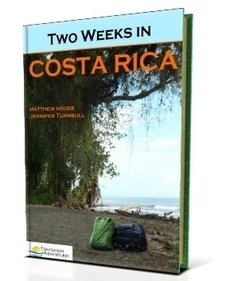
What to Do:
Hiking: The park has five trails. Most trails have fairly flat terrain suitable for all levels, but some have steeper inclines. The park has free trail maps available at the ticket booth, so be sure to take one. Short on time? Stay on the main trail; we’re always astounded at the amount of wildlife hanging out right off the main trail. Have time to spare? Go deeper into the jungle and check out the trails off the main path. They lead to spectacular lookouts, secluded beaches, and see a lot less foot-traffic, so you’re more likely to see rare wildlife. Be sure to keep your eyes and ears open for endangered squirrel monkeys, white-faced capuchin monkeys, howler monkeys, three- and two-toed sloths, coatis, and agoutis that frequent the park.
 View from the lookout at Sendora Mirador (Viewpoint Trail)
View from the lookout at Sendora Mirador (Viewpoint Trail) Beaching it: The park has three beaches that are off-limits to everyone but park visitors. The most famous is the first one off the main trail: Playa Manuel Antonio, a stunning cove with shimmering aquamarine water and ivory sand. With lots of shady almond trees, this beach is perfect for a day of lounging around with a good book. The calm water and sandy sea floor make it a great spot for swimming too.
Snorkeling: There’s some decent snorkeling along the rocks at Playa Manuel Antonio. If conditions are right and the water isn’t too choppy, you’ll be able to see all kinds of tropical fish, from schools of snapper to pufferfish to colorful damselfish.
A Couple Tips:
Got food? Then you better watch out for monkeys! Troops of white-faced monkeys are known to come down to the beach at Playa Manuel Antonio for hand-outs around lunchtime. We’ve even seen them break into the backpacks of unassuming tourists, so keep your belongings in sight at all times. Love the monkeys? Then help keep the monkey population healthy and resist the urge to feed them. Monkeys are extremely sensitive to the bacteria on human hands and can become sick or even die by eating foods that people have touched. Spread the word!
 A white-faced capuchin monkey charming park visitors
A white-faced capuchin monkey charming park visitors Want to avoid the crowds? Skip Playa Manuel Antonio and claim your own piece of paradise at Playa Espadilla Sur farther down the main trail. This beach isn’t quite as picturesque as Playa Manuel Antonio, but having it all to yourself may be worth it.
To Tour or Not to Tour:
Exploring the park on a guided tour is a great option if you haven’t visited before. A guide will teach you about the native plants and animals and spot hidden wildlife with their trained eye. Guides also have powerful scopes that can get you up close and personal with an animal without disturbing it (we’ve even seen the green algae growing in the fur of a slow-moving sloth high up in a tree!).
Not sure you need a guide? If you’ve hiked in Costa Rica before, you can probably manage by yourself and may even see more wildlife on your own because guides work on a time limit, stay on the main trail, and travel with large groups that can scare off wildlife.
When to Go:
Manuel Antonio National Park is one of the busiest parks in Costa Rica. Arrive early to avoid the crowds, especially on weekends. Tour groups typically start showing up around 8:30 a.m., so it’s best to arrive closer to when the park opens at 7:00. Note that in an effort to limit the impact of visitors on local wildlife, the park is closed on Mondays and the number of visitors per day is capped (600 on weekdays and 800 on weekends).
 Questions/Comments:
Questions/Comments:Have questions? Send them our way. We’d love to help you plan your visit to the park!
Been before? Please share your experience. What did you think of the monkeys???
To learn more about Costa Rica, buy our book, Two Weeks in Costa Rica. It's a travelogue with a guidebook twist.
Read reviews and excerpts on Amazon.com

Published on June 24, 2012 09:51
May 28, 2012
A CANOPY ZIP-LINE TOUR IN COSTA RICA
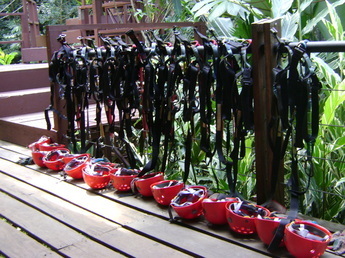
Looking for adventure on your trip to Costa Rica? Try a canopy zip-line tour.
Canopy or zip-line tours can be found throughout Costa Rica—in the cloud forest, near volcanoes, or a short drive from the beach. Each one is different, but they all feature a long metal cable stretching high above the rainforest floor.
Fitted with a helmet, gloves, and body harness, you will be connected to the thick wire braid suspended in the treetops. On the count of three, lift your legs and fly. From platform to platform, tree to tree, you will get a bird’s eye view of the jungle while your heart races.
 Once you open your eyes again, you will see how fun it is. The views are spectacular, and speeding through the air is truly exhilarating.
Once you open your eyes again, you will see how fun it is. The views are spectacular, and speeding through the air is truly exhilarating.Getting comfortable? Try the upside-down Spiderman pose or the classic “no hands.” Some tours also offer other exciting stunts between runs, like rappelling or Tarzan swings.
Nervous? Don’t worry, experienced guides will make you feel safe and secure. For more peace of mind, know that the Costa Rican government highly regulates and inspects these operations to ensure safety.
So if you’re ready for some excitement and want the same view the toucans have, strap in and fly. We did, and had a blast!
Please share your experience zip-lining, where you were and how it was.
To learn more about Costa Rica, buy our book, Two Weeks in Costa Rica. It's a travelogue with a guidebook twist.
Read reviews and excerpts on Amazon.com
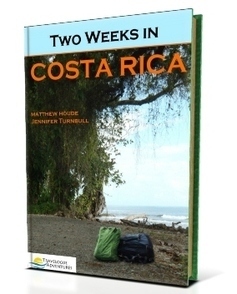
Published on May 28, 2012 14:15



